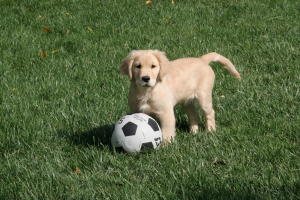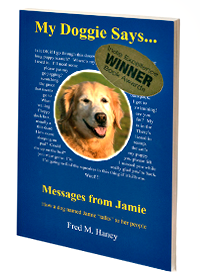So much of dog training — and training people to train dogs — is about getting your dog to obey your commands. This is important. There are times when your dog’s safety depends on obeying a command.
Another theme in dog training is establishing yourself as the alpha pack animal. This helps make life unambiguous for the dog; it knows where it stands in the family order.
That said, I don’t think it’s necessary to train every spec of creativity, initiative, or assertiveness out of a dog. I like a dog that is pleasantly assertive. I don’t know how to train this into a dog, if it doesn’t already have it. But I do think it’s possible to train it out of a dog by being too alpha and too focused on obedience.
Callie’s showing some signs of assertiveness, and we’re glad to reinforce them, within limits. Actually, when she first came to our home, at age eight-weeks, she invited me to play soccer (by sitting behind a soccer ball), and I complied. My compliance surely encouraged her to keep inviting me to play soccer. Which I really like.
The other day, Callie was enjoying her freedom in my office, and I decided to let her walk, without her leash, out to pee. Se we headed for the side yard. But first Callie stopped, picked up her kong toy, and made eye contact, as if to say, “Is it OK if I bring this?” I like to honor her requests, but, knowing how easy it would be for the toy to get lost in the ivy, I decided it was a bad idea.
So off we went to the side yard without the kong toy. But as soon as I opened the door, Callie exploded into a barking, running and slamming-into-the-wall frenzy. Our neighbor’s cat had been basking in the sun atop the wall, and Callie decided to chase her away. Which is fine with me. 🙂
Then, as we walked back to my office, Callie stopped at the sliding glass door to the back yard. The door was open just enough for Callie to get her nose through the opening, but not enough for her to walk through. She stopped and looked right at me. The message was very clear. “Could we please play soccer for a few minutes?” I managed to catch her in action in this photo:
I couldn’t say “no,” so we played soccer for a while. After all, she made such a polite request.
Then, I decided to let Callie join me for a little practice in my golf net. Jamie used to do this all the time. Here’s a photo of Jamie from “My Doggie Says… Messages from Jamie: How a dog named Jamie ‘talks’ to her people.”
But Jamie was not a ball dog, and Callie definitely is a ball dog. So the minute Callie saw the golf balls, she collected two of them in her mouth. She really wanted to chew the golf balls, but I worry about the materials and the possibility that she could swallow one of the balls. Not good. In the end, I had to decide that golf practice wasn’t going to work for Callie, at least not until she matures a little more.
I’m really glad that Callie is asserting herself. She does it in a nice way, but she makes her wishes known. It’s fun to reinforce her assertiveness, when it’s safe and when it doesn’t get out of control.
It seems to be working to let Callie be assertive at times. We still let her know who’s boss, and we continue to insist on obedience. Somehow, I think she understands.


















